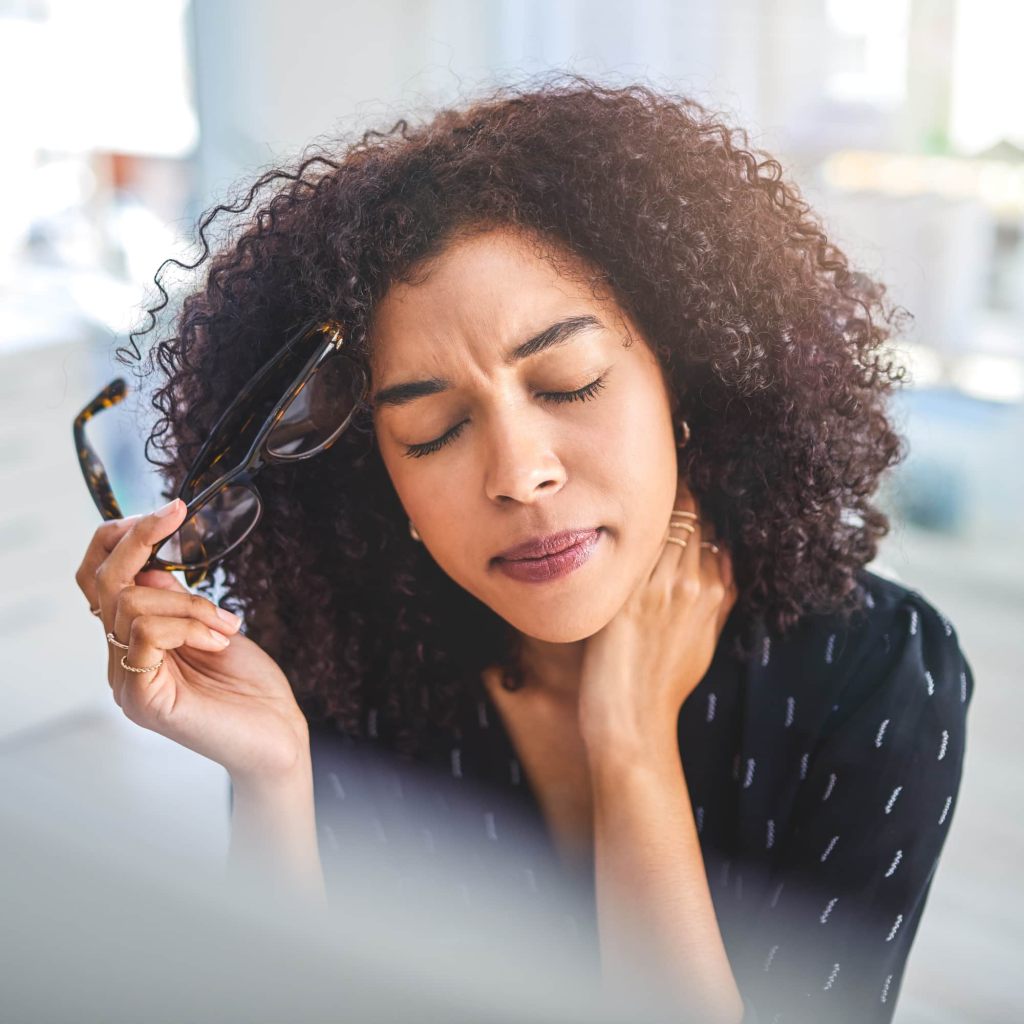We’re all spending more time in front of screens these days, whether we’re talking to family or coworkers on Zoom, scrolling through TikTok dance challenges, or binge-watching television until Netflix asks, “Are you still watching?” While these devices enable us to connect with others and get things done more efficiently, all that time staring at a screen might also be causing you some extra headaches, literally and figuratively.
According to Rizwan Bashir, MD, a board-certified neurologist at AICA Orthopedics, eye strain is the most common culprit behind screen headaches. “When you’re looking at screens for long periods of time, your eyes are straining to focus and engage on the screen, meaning blinking less, focusing too hard, and just overall working overtime,” Dr. Bashir told POPSUGAR.
Howard R. Krauss, MD, a surgical neuro-ophthalmologist at Providence Saint John’s Health Center in Santa Monica, CA, has coined a term for this phenomenon: ocular confinement syndrome, which he describes as “increased irritation, burning, tearing, redness, eye strain, fatigue, and headache, as a consequence of increased screen time at home in relation to quarantine, work from home, and shelter at home.”
Dr. Krauss explained that, when we’re concentrating on a screen, we actually blink less frequently, because blinking would momentarily take our eyes away from what we’re reading or watching. Unfortunately, reduced blinking breaks up the tear film, which covers the eye and helps protect it and keep it moisturized. As a result, our eyes get dry. This naturally causes the brain to want to close the eyelids, “but in our desire to keep watching or reading, we consciously or more often subconsciously struggle to keep the eyes open, leading to more dryness and more muscle spasm, until we end up with ‘eye strain,’ or eye aches or a headache,” Dr. Krauss told POPSUGAR.
Essentially, the screens we can’t seem to quit are causing a battle between our brains and our eyes, and we’re on the losing end. If your eyes are starting to hurt just reading this, first take a nice, long blink – or maybe a few for good measure – and then read ahead for tips on how to keep screen headaches at bay.
Pexels / Elly Fairytale
Give Your Eyes a Break
Both Dr. Bashir and functional optometrist Megan Lott, OD, FCOVD, recommend the 20/20/20 rule. After viewing a screen for 20 minutes, look 20 feet away for 20 seconds. “Your eyes and your visual system were not designed to look at a near target for hours a day, so you must rest your eyes by allowing them to look away,” Dr. Lott told POPSUGAR.
Getty / Westend61
Optimize Your Room Lighting
Remember as a kid, when you used to read in the dark, under the covers, with a flashlight, so your parents wouldn’t know you were still awake? Don’t do that with your devices. Dr. Bashir recommends having plenty of light in the room, as this may be the number-one cause of screen headaches. Find a room that is well lit, whether that’s with natural sunlight or lamps.
Pexels / Ken Tomita
Check Your Desk Setup
If you spend hours a day on the computer, try looking at your monitor when it’s off to see if there’s any light reflected on it from windows or light fixtures. “[These reflections] may not be evident when the screen is on, but nonetheless may produce glare, which may potentially trigger migraine,” Dr. Krauss told POPSUGAR. If you can adjust the position of you screen to reduce glare, do it.
Dr. Bashir also stressed the importance of making sure your monitor is at eye level, which will encourage proper posture. Bad posture can lead to neck and shoulder pain, which in turn can contribute to headaches.
Getty / santypan
Wear Glasses When Using Screens
“Eyeglasses ease focusing strain, may reduce glare, and help to block drying airflow across the eyes,” Dr. Krauss said. If you’re lucky enough to not need prescription glasses, consider blue-light-blocking lenses, which Dr. Lott says can help relieve problems with glare.
Getty / JGI / Jamie Grill / JGI/Jamie Grill
Use Eye Drops Throughout the Day
On particularly busy days (or while you’re looking at particularly engrossing videos on your phone), you’ll likely forget to blink. Dr. Krauss suggests looking into a regular regimen of preservative-free, ocular-lubricating drops. Use them several times a day or more if your eyes are feeling especially dry.
Getty / Peopleimages
Calm Your Eyes With Moist Compresses
To relieve any muscle spasm, place warm moist compresses over your closed eyes, Dr. Krauss advised. If your eyes are experiencing really painful spasms, try “alternating iced moist and warm-to-hot moist compresses, each for two to three minutes for a 15-minute cycle. The ice helps to block pain and the warmth helps to relieve muscle spasm,” he said. Think of it as an excuse to give yourself a mini spa treatment in the middle of the day.
Getty / Moyo Studio
Know When to Call a Doctor
Sometimes, headaches can be caused by something beyond regular eye strain. “When looking at a screen, or anything at near point, your accommodative and binocular system must work in tandem with each other,” Dr. Lott explained. “Often people who have headaches have difficulties with one of these two systems. It is called binocular dysfunction. This can cause headaches across the forehead typically, words to float and move on the page, and poor reading comprehension.” If you’re experiencing any of these symptoms, find a doctor near you who can help prescribe the appropriate corrective lenses or vision therapy.

